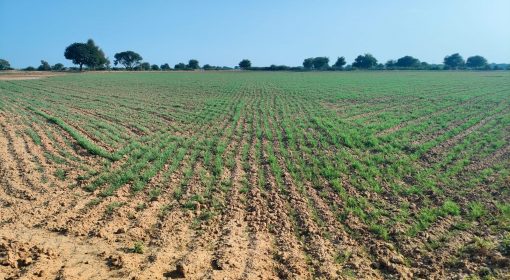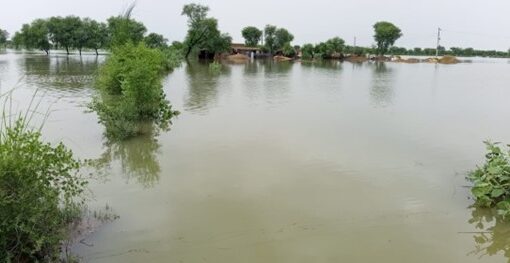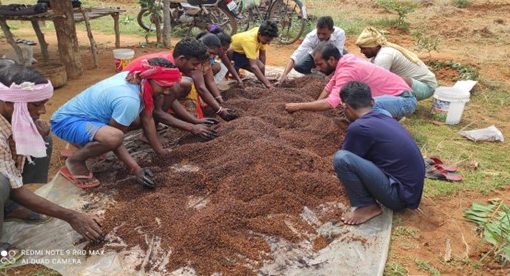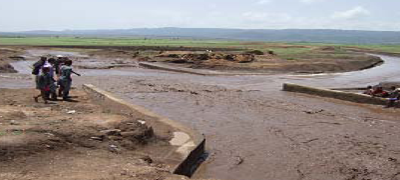by Allah Bakhshh, and Frank van Steenbergen. With inputs from Reinier Veldman
June 05, 2020
Postcard from Bagh Nari, Pakistan, from the extensive ‘spate-irrigated’ lands. Spate irrigation is a unique flood-based agricultural water management system that makes use of short duration floods in normally dry rivers to irrigate land or improve local vegetation. Here floods are not a threat, but a blessing. This type of flood-based farming is common in all provinces of Pakistan and stretches over an area of more than 1 Million hectares. Globally the area under spate irrigation is probably close to 3-5 Million hectares (www.spate-irrigation.org).
Bagh Nari, the world’s single largest spate irrigation system, is located in the Kachi Plains of Balochistan Pakistan, where the Nari River and off-shoots of the Bolan and Lehri River come together. The short duration floods are diverted to more than 100,000 ha of land, grown with sorghum, oil seeds and pulses. This land is built up from the silt that is annually renewed with the sediment-laden flood rivers. Farmers have developed flood based agriculture over centuries in this part of the Province. Now hundreds of small and medium villages are living of the seasonal flood generated agriculture. Drinking water comes from surface water ponds filled with the same flood water as groundwater is saline and not useable for any purpose in the Kachi Plain. The Kachi plain consists of 4 districts Sibi, Bolan, Jhal Magsi and Lehri.
The year 2019-20 started good. There was a good succession of short duration floods in June-July 2019. They were neither too small nor too forceful. The system is that this flood water is diverted from the riverbeds by large constructed earthen bunds. It is then routed through an extensive system of earthen channels till the flood water is spread on large fields surrounded by earthen perimeter walls. After the fields are inundated, the lands are ploughed and planked – so as to store soil moisture. Cultivation starts later when the weather is less inclement. It is important for the spate irrigated areas to ensure that moisture is available for the cultivation of sorghum, wheat, chickpeas and oil seeds – the typical crops in spate-irrigated crops.
Yet things changed in the winter season this year. Winters normally start from November. It Is the time for wheat, barley, chickpeas to be cultivated. However, what started as a good year, became a poor year. Excessive rains, fog and wet weather spoiled the standing summer crops. Then there were the locust attacks building up from early January 2020. The locusts entered from the Southwest, from Iran and the Southern Balochistan Desert. Locusts were foraging on green winter pastures all along their way. In their grand tour they first travelled to the spate irrigated areas in the South of the country: Dadu, Jamshoro and Lasbella. They then further moved down to canal command irrigation system of Sindh Province mainly remaining in southern districts of Badin, Thattha, and part of Narra canal areas. Reportedly, from here the swarms divided into two directions. One branch travelled onwards to Southern Punjab. The other mega-swarm travelled westward to Jacobabad, Larkana and Shahdad Kot. From there it entered into the Kachi Plains and attacked crops in Dera Murad, Jhal Magsi and Jafferabad district and spate irrigated areas of Bagh Nari as well. In this part of Balochistan the swarms of locusts kept moving with inflicting minor damages to the crops. The locust then further travelled to west and entered in the Balochistan highlands. The weather was chill and it temporarily reduced the locust population. In April the locust re-emerged again in the hot areas of Kharan, Nushki , SIbi, Dhadar, Bolan and Bhag area but the swarm was less. There were not many crops on the land and losses were only minor. But reportedly the locusts damaged the range land which was green at this time of year due to the rains (See map below indicating locust movements).
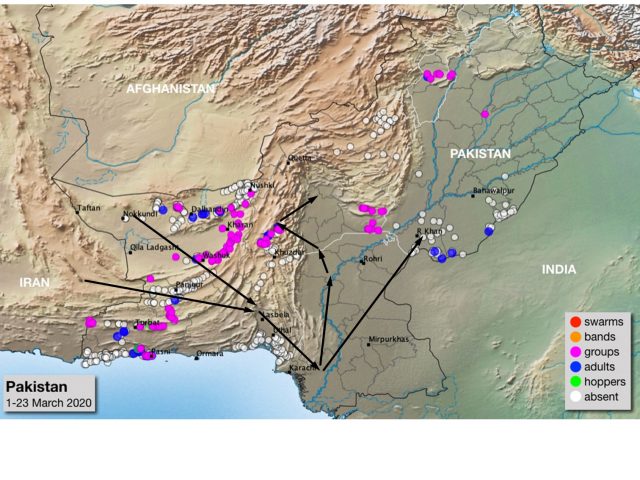
A wide difference in winter crop yields was seen on different types of soil in wake of higher humidity, a trend visible since the last 3 years. There was a clear difference in crops grown on century old developed fields that contains higher clay content compared to the crops on recent sandy soils in the same ecology. Crops like wheat and chickpeas grown on sandy soil did much better than the crops cultivated in clay loams fields. The main reason is the absorption of moisture in two types of soils: clay keeps moisture for longer time but in the humid conditions this caused root rot of the plants. Sandy soils on the hand retain less moisture, which may cause the crop to suffer from moisture deficit but also protects it from rot. The risk of moisture deficit however is reduced when the plants grow up quickly and develop a dense canopy, sheltering the soil surface from exposure to sun.
There were long spells of high humidity coupled with fogs throughout the winter months. Tree and green crops like wheat and chickpeas were loaded with dews drops in the morning, before the sun started to shine. The dew washed the plants, reduced the soil temperature and slowed down the ripening of the crop. There were very frequent mild to heavy rains this year which affected plant health. The wheat and chickpeas seeds that usually sprout into many shoots and bear the pods developed early shoots. These new twigs however were killed by the cold and did not reach to the fruit bearing stage, this resulted in reduced quantities of grains compared to a normal year.
In addition, due to heavy cold combined with the fogs and rains, the chickpea crop did not bear much flowers which is necessary for the grain setting. At the normal harvest time in Mid-April for the wheat and chickpeas, chickpeas plants were still green meaning that plants grow well but due to unwarranted moisture it increase the biomass rather than the fruits. The chickpeas were later on attached by the crawling bugs that have punctured the pods and eaten up the tiny green grains inside it. Some farmers estimated that the chickpeas production was reduced to 50% of a normal year. Moreover the quality of grain was weak and rusty that did not make good market return. Instead, the dried biomass after threshing will be more useful to feed animal as fodder.
When the chickpeas and wheat crops were ready from the first week of April, due the COVID-19 lockdown and the travel restriction, there was a shortage of labour and harvesting machines could not move. Also available labour was more expensive than normal times, since some daily wage earners were striving to get government support rather than working in crop harvesting.
Due to persistent rains, the fields remained muddy even at the and chickpeas plants are although dried up but harvesting labour could not access the plants to cut. Visakh (14th April to 13th May in Indian calendar) comes with hot wind winds which dries up the chickpeas and wheat crops in a week time and make them ready to cut. Normally, mid-April is considered start of summers when days are hot and nights are moderate with day time temp from 37-40 degree Celcius and nights remains mostly around 30 degree Celcius but this year it was still raining two times in a week with an average and temperatures are not exceeding 30 degree which is not useful to the ripen chickpeas and wheat crops. Still in many parts, the harvested wheat and chickpeas are piled up in bundles and are still lying scattered in the field since rains are not allowing them to dry up and get ready for threshing.
On flora and fauna, it was visible also that due to the unexpected humid winter, trees did not bear the flowers this year. Otherwise the Acacia Tree bears seeds pods early in the year. They were lush green but without any seed pods. There was a also change with the jujubes (spinicristi), that bring wild fruits for human and animals in dry land areas. The jujube trees had a lot of fruit this year, but neither human nor animals were are eating them as they did not have their normal taste of normal year. Other trees like jaal started bearing their leaves whilst it was still the fruiting season. In other years, jaal never shed leaves. Spate fields are covered with dense wild grass and weeds – much more than in dry years, entirely changing the outlook of these dry land ecologies.
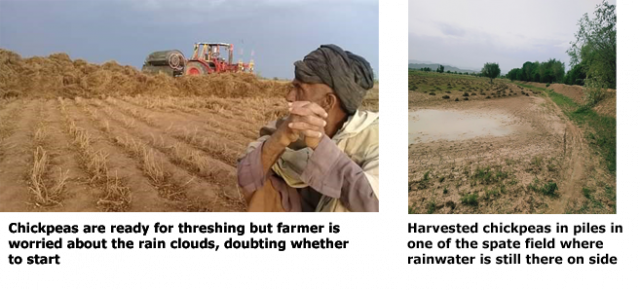
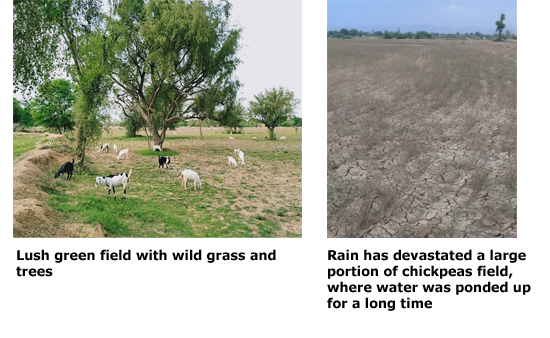
(from The Book of Rain)

